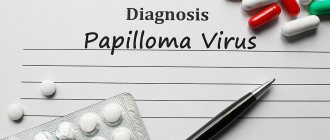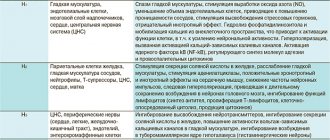Antiviral drugs are drugs intended to treat infections of viral origin.
Viruses belong to a special type of microorganisms; they can only conditionally be called alive. Outside the host's body, they do not exhibit the properties of life - they have no exchange of energy and matter with the environment, and outside the body they are not capable of reproduction. Viruses are intracellular pathogens. Having penetrated the cell, they subjugate the protein - the cell’s synthesizing apparatus, which begins to assemble viral particles instead of the proteins necessary for the life of the cell. When a critical accumulation of viruses inside the cell is reached, it ruptures, accompanied by cell death and the release of newly synthesized viruses into the extracellular space. In this case, infection of nearby tissue cells occurs.
A certain type of virus, as a rule, affects certain organs and tissues. This phenomenon is called tropism. For example, viruses that cause acute respiratory diseases affect the respiratory system, viruses that are tropic to liver cells - acute and chronic hepatitis, viral infections that cause diseases of the central nervous system - viral encephalitis, enteroviruses cause diseases of the gastrointestinal tract, human immunodeficiency virus specifically damages cellular immunity.
The human body has a specific protective antiviral system. In response to the invasion of the virus, a special protein is produced - interferon. Interferon blocks the ability of viral particles to replicate or enter the cell. If the interferon system is ineffective, a viral infection can lead to the death of the host organism.
pharmachologic effect
Antiviral agents have different mechanisms of action. They can block the virus from entering the cell, making it impossible to reproduce. The virus remains in the extracellular space, where it is easily detected by the immune system and destroyed. Other antiviral agents block the multiplication of a virus that has already penetrated the cell. For example, acyclovir and penciclovir are analogues of a DNA fragment. During reproduction, the virus includes acyclovir in its DNA, which makes its further extension impossible. This effect is called replication blocking.
In contrast to direct antiviral agents, there is a group of drugs classified as interferon inducers. They do not have a direct antiviral effect, but when introduced into organisms they activate the synthesis of their own interferon, thus increasing the overall resistance of the body to viral infection. They are prescribed mainly for acute respiratory viral infections, genital and labial herpes and herpes zoster. Interferon preparations are used primarily for the treatment of acute and chronic viral hepatitis, as well as for the prevention and treatment of acute respiratory viral infections.
Neuraminidase inhibitors
Neuraminidase, found on the surface of influenza viruses type A and B, is one of the key enzymes involved in their replication. Despite the fact that the genetic structure of influenza viruses and, accordingly, neuraminidase itself is constantly changing, the amino acid sequence of the active site of the enzyme remains constant, which makes it an optimal target for antiviral therapy [1].
Inhibition of neuraminidase disrupts the ability of viruses to penetrate healthy cells, inhibits the release of virions from infected cells and reduces their resistance to the inactivating effect of mucous secretions of the respiratory tract. This stops the further spread of the virus in the body. In addition, neuraminidase inhibitors reduce the production of pro-inflammatory cytokines, thus preventing the development of a local inflammatory response and reducing the manifestations of a viral infection (fever, malaise, etc.) [1].
It is important that the frequency of resistance of influenza A and B viruses to neuraminidase inhibitors is about 2%. Currently, there are two drugs in this group - oseltamivir and zanamivir. The first is intended for oral administration, and the second is used only by inhalation.
The effectiveness of both neuraminidase inhibitors has been proven in large-scale clinical studies. Thus, in patients with a confirmed diagnosis of influenza, while taking oseltamivir, the severity of the disease, which was assessed by the total symptom index, decreased by 38% compared to those who received placebo. The drug reduces the incidence of complications (bronchitis, pneumonia, sinusitis, otitis media) by approximately 50% (in young patients without concomitant diseases) [4]. In accordance with WHO recommendations, the use of oseltamivir is the main method of combating influenza in the event of a pandemic [5].
The preventive activity of oseltamivir has also been confirmed in clinical studies. It has been proven that taking it significantly reduced the frequency of virus shedding and prevented its transmission from one family member to another. Oseltamivir reduces the incidence of influenza in healthy (unvaccinated) adults by 76% (when taken for 42 days - this is the maximum duration of seasonal prophylaxis), and in elderly patients (vaccinated) - by 92% [1].
Zanamivir also alleviates the course of influenza, reduces the number of complications (by 22% compared to placebo), and reduces the frequency of antibiotic use. The percentage of effective protection of zanamivir as a drug for the prevention of disease is 67–79% compared with placebo [4].
Oseltamivir is used to treat and prevent influenza in adults and children over 1 year of age, and zanamivir in adults and children over 5 years of age. Both drugs are available with a doctor's prescription.
Side effects
While taking neuraminidase inhibitors, nausea and vomiting may occur, however, as a rule, these reactions occur in the first two days after the start of treatment and in the vast majority of cases - once.
What should you tell the buyer?
- Neuraminidase inhibitors can be taken with or without food. However, oseltamivir is better tolerated if taken with food.
- Drugs in this group are most active against the influenza virus when taken early: in order to achieve a good therapeutic response, it is important to take them no later than 2 days after the onset of symptoms. Therefore, if the doctor has prescribed them, it is important to start treatment immediately.
- For prevention, it is also important to take oseltamivir no later than 2 days after contact with patients.
Classification of antiviral agents
Antiviral drugs are classified depending on the diseases that are caused by certain viruses.
- Medicines for the treatment of influenza (rimantadine, oseltamivir, umifenovir)
- Antiherpetic and anticytomegalovirus infections (acyclovir, valacyclovir, famciclovir, ganciclovir, ribavirin)
- Antiherpetic agents for topical use (acyclovir, penciclovir)
- HIV medications or antiretrovirals (abacavir, zalcitabine, zidovudine)
- Interferon inducers (enisamium iodide, tilorone, indolecarbinol, kagocel, meglumine acridone acetate, sodium ribonucleate)
- Interferons (leukocyte alpha interferon, recombinant alpha interferon)
- Other agents (oxaline)
M2 channel blockers
Both representatives of this class - rimantadine and amantadine - are adamantane derivatives. Today, only the first is used as an antiviral drug. Rimantadine, first synthesized in 1963, is indicated for the early treatment and prevention of influenza caused by influenza A virus in adults and children over 7 years of age. Its mechanism of action is based on blocking special M2 ion channels of the virus, which leads to disruption of its ability to penetrate cells and release ribonucleoprotein. This inhibits the most important stage of viral replication—the release of the viral genome in the cell [1].
It is important that during the use of M2 channel blockers, resistance may develop. Its frequency by the 5th day of treatment can reach 30% [1]. Thus, it is known that all 100% of the H3N2 influenza strains, as well as the swine flu pathogens that caused the epidemic in 2009, were resistant to this drug [2]. Due to the resistance of pathogens to rimantadine, the advisability of its use in recent years has raised more and more questions among specialists.
Side effects
Rimantadine cannot be said to have a favorable safety profile. It causes a number of undesirable reactions from the gastrointestinal tract and nervous system. According to the findings of the Cochrane Collaboration study, which examined the activity and safety of amantadine and rimantadine, drugs in this group should be used only in emergency situations when other drugs do not show a therapeutic effect [3].
What should I remind the buyer about?
When dispensing rimantadine, the buyer should pay attention to possible drug interactions. It is known that when rimantadine is used together with drugs that are very often used to treat influenza and ARVI - paracetamol and ascorbic acid - the absorption of the antiviral drug is reduced by approximately 11% [4].
In addition, it is appropriate to remind the consumer that if changes in health occur, in particular, tachycardia, insomnia, unusual headache, shortness of breath, nausea, vomiting and other side effects, they should be reported to the doctor immediately [4].
Be careful - depending on the brand name, rimantadine medications are available with or without a prescription.
Features of application
Since in most cases the independent use of antiviral drugs, without a doctor’s prescription, is unacceptable, here we will talk about drugs with a good safety profile that can be used independently, if appropriate symptoms occur, or for prophylactic purposes.
Oxolinic ointment is used mainly for the prevention of viral infections transmitted by airborne droplets. It is applied in a thin layer to the nasal mucosa - the entrance gate of respiratory infection. Drops and sprays containing interferon are used for the same purpose.
Topical forms of acyclovir and penciclovir are used to treat herpes labialis. They should be started to be used as early as possible, when the first symptoms appear - itching and redness. When applying the drug to the skin or mucous membranes, it is necessary to ensure that it does not come into contact with particles of infected, exfoliating tissue on healthy skin in order to prevent its infection.
Other antiviral drugs
This subgroup includes a number of drugs active against respiratory viruses. They can exhibit both a direct antiviral effect and work by modulating the immune response.
Pentanedioic acid imidazolylethanamide is a domestic antiviral drug, the active component of which is a low-molecular compound isolated from the nervous tissue of a marine mollusk. Approved for use since 2008. In the experiment, it demonstrated effectiveness against strains of influenza A and B virus, adenoviral infection, parainfluenza and respiratory syncytial infection [6].
According to a number of studies, the antiviral properties of the drug are based on the ability to suppress virus reproduction at the nuclear phase. It also activates the interferon system, increasing its content in the blood to physiological norms, and exhibits a number of other effects that increase the immune response.
Used to treat influenza and other acute respiratory viral infections in adults and children over 13 years of age. Dispensed without a doctor's prescription.
Inosine pranobex
- a synthetic purine derivative that has an immunostimulating and nonspecific antiviral effect. In vivo active against herpes simplex viruses, cytomegalovirus, measles virus, influenza A and B viruses, polioviruses and some others. The mechanism of antiviral action is associated with blocking viral RNA and inhibition of the enzyme involved in the replication of viral particles. The drug suppresses the biosynthesis of viral RNA and the translation of viral proteins, and also increases the production of alpha and gamma interferons [4].
Indicated for use in the treatment of infections caused by sensitive pathogens in adults and children over 3 years of age. The off-label indication, that is, not indicated in the instructions for use, but used in clinical practice, is the treatment of acute and chronic respiratory viral infections [7]. The drug belongs to the Rx group.
Kagocel
- a high-molecular compound synthesized on the basis of carboxymethylcellulose salt and natural polyphenol obtained from plant raw materials (cotton). According to the manufacturer, the main mechanism of action is the induction of the formation of late interferon, which is a mixture of alpha and beta interferons with high antiviral activity. According to the manufacturer, the drug activates the production of interferons in almost all cells participating in the immune response [8].
Indications for use: prevention and treatment of influenza and other respiratory infections in adults and children over 3 years of age, as well as treatment of herpetic infections in adults. Dispensed without a doctor's prescription.
Tiloron
- another low-molecular synthetic inducer of interferon synthesis that has an antiviral effect. According to the instructions for use, the drug stimulates the formation of alpha, beta and gamma interferons. Active against various viral infections, hepatitis and herpes. The mechanism of antiviral action is associated with inhibition of the translation of virus-specific proteins in infected cells, due to which the reproduction of viral particles is suppressed.
Indications for use: treatment and prevention of influenza, other acute respiratory viral infections, as well as treatment of a number of other viral infections (herpes, cytomegalovirus infection, etc.) in adults and children over 7 years of age.
Be careful - depending on the TN and dosage, the drug may have a prescription.
Umifenovir
- a domestic drug that exhibits an antiviral effect. The mechanism of action is based on preventing the fusion of the lipid membrane of the virus with cell membranes. In addition, the drug has moderate immunomodulatory properties, which increase the body's resistance to viral infections.
It has been proven that umifenovir suppresses in vitro influenza A and B viruses, including their highly pathogenic subtypes, as well as ARVI viruses (rhinovirus, adenovirus, respiratory syncytial virus, parainfluenza virus). Umifenovir has been proven to be active against the SARS coronavirus (9), which is 79.5% identical to the causative agent of the current pandemic SARS-CoV-2 [1]). Today, clinical trials are studying the effectiveness of the drug against the COVID-19 pathogen.
Domestic temporary clinical recommendations for the treatment of patients with COVID-19 indicate that umifenovir can be used for coronavirus infection SARS-CoV-2, however, currently available information on the results of therapy with its use does not allow us to draw an unambiguous conclusion about its effectiveness or ineffectiveness [ eleven].
According to the instructions for use, umifenovir is indicated for the prevention and treatment of influenza A and B, other acute respiratory viral infections, including those complicated by bronchitis and pneumonia, as well as severe acute respiratory syndrome associated with coronavirus infection in adults and children over 2 years of age. Dispensed without a doctor's prescription.
Interferons
- biologically active proteins that are synthesized by the cell during a defense reaction. Through receptors, interferons act on other cells, increasing the body's resistance to viruses. According to the method of production, leukocyte, lymphoblastoid and recombinant interferons are distinguished. The latter are most widely used in the practice of pharmaceutical specialists (interferon alfa-2b) [1].
The mechanism of the antiviral action of interferons is to suppress the synthesis of viral proteins and their replication, as well as induce cell resistance to viral infections. Alpha interferon preparations do not have specificity; their antiviral activity extends to various viruses, including respiratory viruses [1].
There is evidence of the activity of interferon alpha-2b against SARS. It has been proven that the drug ensures the production of its own interferon, the synthesis of which is blocked by the coronavirus [12]. Today, local forms of interferon (intranasal and inhaled) are included in Russian, Chinese and Spanish recommendations for the treatment of COVID-19 as drugs for the prevention of infection in adults (including pregnant women) and children, as well as for the treatment of mild forms of the disease in patients under 60 years of age [13]. Most interferon alfa-2b TNs are available without a prescription.
What should you tell the buyer?
As a rule, all of the listed drugs are well tolerated, which is confirmed by the fact that most of them belong to the over-the-counter group. When releasing them, it is worth reminding the client that the effectiveness of antiviral drugs is greatest with early treatment - in order to achieve an optimal therapeutic response, it is important to start taking them in the first hours or days (usually up to 2 days) after the onset of symptoms of the disease. The same rule applies to prevention - maximum protection is achieved if the drug is started as soon as possible after contact with the patient.
Sources
- Clinical pharmacology and pharmacotherapy: textbook. – 3rd ed., add. and processed / ed. V. G. Kukesa, A. K. Starodubtseva. – M.: GEOTAR-Media, 2012. – 832 p.
- Antiviral Agents for the Treatment and Chemoprophylaxis of Influenza: Recommendations of the Advisory Committee on Immunization Practices (ACIP).
- Jefferson T. et al. Amantadine and rimantadine for preventing and treating influenza A in adults // Cochrane Database of Systematic Reviews. 2004; 3.
- According to GRLS data as of 04/09/2020.
- Volchkova E. Neuraminidase inhibitors in the treatment and prevention of influenza // Doctor, 2009. No. 1. P. 22–26.
- Shuldyakov A. A. et al. Clinical and epidemiological effectiveness of the antiviral drug Ingavirin® // Pulmonology, 2014. No. 4. P. 62–69.
- Belyaeva L. M. Groprinosin in the practice of a pediatrician // Medical news, 2012. No. 3.
- Kharlamova F. S. et al. Possibilities of using the antiviral drug Kagocel® for the prevention and treatment of influenza and other acute respiratory infections in frequently ill young children // Effective Pharmacotherapy, 2012. No. 53. pp. 26–35.
- Grigoryan S. et al. Amiksin: induction of interferons-α, -β, -γ And-λ in blood serum and lung tissue // Breast Medical Review, 2015. No. 2. P. 93.
- Khamitov RA, Loginova S, Shchukina VN, Borisevich SV, Maksimov VA, Shuster AM. Antiviral activity of arbidol and its derivatives against the pathogen of severe acute respiratory syndrome in the cell cultures. Vopr Virusol 2008; 53:9–13.
- Prevention, diagnosis and treatment of new coronavirus infection (COVID-19). Temporary guidelines. Version 5 (04/08/2020).
- Zhou P. et al. A pneumonia outbreak associated with a new coronavirus of probable bat origin // Nature. 2020; 1–4.
- Omrani AS et al. Ribavirin and interferon alfa-2a for severe Middle East respiratory syndrome coronavirus infection: a retrospective cohort study // The Lancet Infectious Diseases. 2014; 14 (11): 1090–1095.




